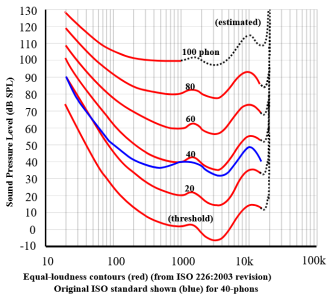I don't see how this isn't possible on the wiim amp. Sure it's kinda pointless in the wiim mini, pro and pro plus, but with the wiim amp, the amp is the only device between the music and the speakers, so a loudness feature becomes more interesting.
It cannot be hard to implement effectively with modern equipment, one my older amplifiers is a 1972 sherwood s7200 and it has a loudness control that works just fine at low volumes, and correctly modifies the sound less as the volume increases, all without the benefit of a DSP or processor.
Some Yamaha amps even have a variable loudness control with different curves depending on the users need.
Many users of the wiim amp are connecting it to small bookshelves, a loudness feature makes sense in this scenario.
I didn't say it's impossible, as it has been done (kind of) for decades, even with analog technology. If it has been done successfully mainly depends on your expectations.
Some people (not here in this forum, of course) seem to believe that implementing equal-loudness contour was somehow
necessary to overcome
defects of human hearing. This is simply not the case. These curves represent (on average) a
characteristic of human hearing, not a defect.
If you listen to a real concert at its natural level, this is the real thing. There's nothing to compensate. Even if, technically speaking, a certain SPL form a double base will
not sound exactly as loud as the same SPL from a violin, this is how it is. This is how music sounds to us human beings. If somebody recorded this concert for you (mics right above your head) and you play back that recording at home at exactly the same SPL, then again there's nothing to compensate for (except room influences, but this is a different topic). I hope we are in agreement so far.
The "problems" only start, when for practical reasons (like neighbours, partners or cats) you cannot play back the concert at the original level, but more quietly. If the violin was originally playing say a 1 kHz note at 60 dB (equalling a loudness of 60 phon) and the double bass a 100 Hz note at 60 dB (equalling ~42 phone), but now the recorded violin plays at 40 dB (loudness of 40 phon), then the double bass will play its tone at 40 dB as well, but this leads to a loudness of just ~17 phon. So, the difference in perceived loudness is 20 phone for the violin, but ~25 phone for the double bass. This difference is what loudness or contour tries to correct for. I hope we still agree on that. It's just a slightly cocky way of saying that you will hear less bass as the volume is turned down.

Here comes our amplifier (of pre-amplifier, it really doesn't matter
that much) and applies a matching contour function. As part of that correction it will lift the bass response at 100 Hz by 5 dB (and a correction following ISO 226 for all other frequencies, of course). Job done? No. Different playback levels will demand different levels of correction. The lower the playback level, the higher the required amount of correction for highs and lows. So, if you listen to the violin e.g. at 20 dB SPL, the amount of required correction will vastly differ from the 40 dB SPL example.
Trouble is, the amplifier (not even the WiiM Amp with everything in one box) really knows, what the actual SPL will be at your eardrums. It does know the selected volume level. It could even sense (at least in theory) the voltage at the speaker outputs. But it doesn't know the sensitivity of your speakers, nor your individual listening distance. Both factors combined can easily mean a 20 dB difference in SPL with the same volume setting. Bummer, a 20 dB difference in SPL will require a totally different amount of loudness compensation.
Using a microphone with absolute calibration, this problem could be mitigated. Different levels of different sources could introduce more variables. In addition, it is not possible or even desirable to fully compensate at very low levels, as
@adias has pointed out.
What can be achieved is just an approximation. It might well make the illusion created by our hifi gear more pleasant and more enjoyable. It's just not really providing a higher fidelity. Nothing wrong with such a feature from my point of view, als long as I can enable and disable it any time.



